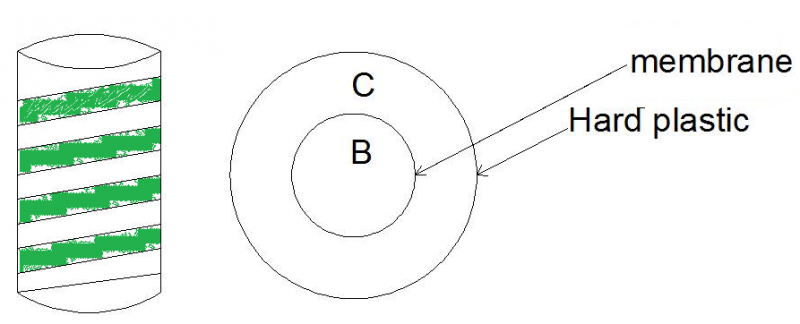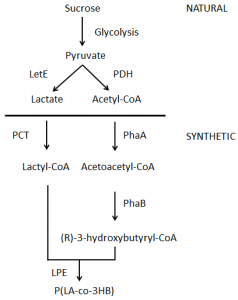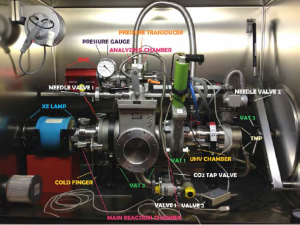Biological system reduces amount of freight for delivery to orbit

Ever wondered why humans have not colonized Mars, or traveled further into space? We have. It is not because the technology is lacking – in fact, using the technology we have today it might be possible to achieve these aims (Wall 2013). The main limiting factor is the cost. For instance, the Curiosity mission cost 2.8 billion US dollars. During the mission, a rover was sent to Mars to investigate the composition of the soil. The cost of this was not insanely high, but with a budget for space exploration that keeps being cut by governments of developed countries around the globe (Luxton 2016); it is hard to find the money for longer, manned missions in space.
One of the main costs is the external fuel tank (Giges 2014). The more you have to load on the space rocket, the more fuel it needs to launch, and the more the mission will cost. Therefore, it would be desirable to decrease the amount of fuel that is needed to have on the space rocket prior launching. CosmoCrops has a solution to this!
Engineered Bacillus subtilis for the rescue!
What we are working on this summer, is to make a biological system that can reduce the amount of material you need to have on board on the space rocket prior to launching. This is done by using two different organisms that will work together in a co-culture. The idea is that when the astronauts or settlers on other planets need food, drugs or any organic material, they can simply produce it themselves. The co-culture will be designed in such a way that it allows for a high degree of modularity (Fig. 1), allowing the astronauts or settlers to take out one component and add another engineered microorganism. This means that the co-culture system could be used to produce almost everything – as long as you have a microorganism that can produce it.
The two organisms we will use are the cyanobacterium Synechococcus elongatus and Bacillus subtilis. The cyanobacterium will be the driving force of the system, using sunlight and carbon dioxide to produce sucrose. This sucrose will then be secreted by the sucrose transporter cscB (Ducat et al. 2012). Hereafter, the secreted sucrose will be used by B. subtilis to produce whatever compound is desired. B. subtilis can form spores, meaning that prior to launching it will be possible to have different engineered forms of Bacillus spores on the shelf. Here, they can be stored for a long time without the need of any nutrition. When the astronauts/settlers need something, they find the corresponding engineered spores and put them into the co-culture system.

The Genetic Approach
As a proof of concept, we will engineer B. subtilis to produce the bioplastic P(LA-co-3HB) that can be used in the 3D printer currently on the International Space Station. To do this, we introduce four enzymes to B. subtilis (Taguchi et al. 2008; Jung et al. 2010; Yamada et al. 2010) (Fig. 2). These four enzymes are a propionate-CoA transferase (PCT) from Clostridium propionicum, β-ketothiolase, (PhaA) and acetoacetyl-CoA reductase (PhaB) both from Ralstonia eutropha and lactate polymerizing enzyme (LPE). LPE is originally a Pha synthase that has been mutated to use lactyl-CoA as a substrate (Taguchi et al. 2008). Together, these four genes introduce a new sink pathway for carbon. Because of this it might be necessary to make some genomic alterations to optimize the yield, which has been done in Escherichia coli (Jung et al. 2010).
The Jens Martin Mars Chamber
Besides the genetic approach, one aspect of this project is also to test the B. subtilis strain in the Jens Martin Mars Chamber (Fig. 3) at the Niels Bohr Institute. This is a chamber that can simulate the environment in space or on Mars by controlling factors such as temperature, pressure, UV radiation and the atmospheric composition (Kajtár 2014).
The chamber is essentially a doubly sealed environment (several airtight layers) with industrial vacuum pumps, UV-lamps, oven elements, Peltier panels and water cooling. All this allows for experiments in pressure as low as around the Moon, from Arctic temperature to several hundred degrees with or without UV radiation. For normal pressures, it also allows altered atmospheric compositions.
By testing our B. subtilis strain in this chamber, we hope to stimulate some mutations that can make the strain more viable in extreme environments as space or Mars. This will be done by inducing mutations in the genome of the bacterium by UV mutagenesis. If viable cells are observed after being tested for one or several of the parameters, one approach will be to test it more thoroughly with all the parameters, to see if it can survive. It the cells do survive then whole genome sequencing will be carried out and bioinformatics will be used to find the mutations that alloe the cells to survive.

Future Perspectives
With our project, the future is brighter for space exploration. When the co-culture system is functional, it can be used to produce not only bioplastic, but a variety of different compounds that can make space missions more feasible. Furthermore, it will make it cheaper to perform space missions, because there is no need to have so many materials on board on the rocket before launching, simply just the co-culture, spores of B. subtilis and a 3D printer – then everything else can be made out in space. It will also be used for future settlements on other planets, so they are not dependent on Earth for materials, but can produce what they need by themselves. Thereby, making the lives of new settlers easier than it otherwise would be.
The CosmoCrops
CosmoCrops is an interdisciplinary team from University of Copenhagen that consists of 10 undergraduate and graduate students. In June CosmoCrops won the Nordic iGEM Conference held in Stockholm, Sweden by having the best presentation and project among the Nordic teams. We can be followed on Facebook and Twitter if you want to stay tuned!
More information: Ducat D.C., Avelar-Rivas J.A., Way J.C. & Silvera P.A. (2012) Rerouting carbon flux to enhance photosynthetic productivity. Applied and Environmental Microbiology 78, 2660–2668.
Giges N.S. (2014) Massive Fuel Tank to Cut Future NASA Costs. ASME – Setting the Standard.
Jung Y.K., Kim T.Y., Park S.J. & Lee S.Y. (2010) Metabolic engineering of Escherichia coli for the production of polylactic acid and its copolymers. Biotechnology and Bioengineering 105, 161–171.
Kajtár R.E. (2014) Mars Environmental Chamber for Simulation of Weathering Processes on Mars. University of Copenhagen.
Luxton E. (2016) Which countries spend the most on space exploration? World Economic Forum.
Scienceogram (2015) The cost of space missions. Scienceogram.org.
Taguchi S., Yamada M., Matsumoto K., Tajima K., Satoh Y., Munekata M., et al. (2008) A microbial factory for lactate-based polyesters using a lactate-polymerizing enzyme. Proceedings of the National Academy of Sciences of the United States of America 105, 17323–7.
Wall M. (2013) Incredible Technology: How to Launch Superfast Trips to Mars. Space.com.
Yamada M., Matsumoto K., Shimizu K., Uramoto S., Nakai T., Shozui F., et al. (2010) Adjustable Mutations in Lactate (LA)-Polymerizing Enzyme for the Microbial Production of LA-Based Polyesters with Tailor-Made Monomer Composition. Biomacromolecules 11, 815–819.
Provided by Public Library of Science
This story is republished courtesy of PLOS Blogs: blogs.plos.org.




















